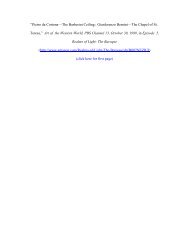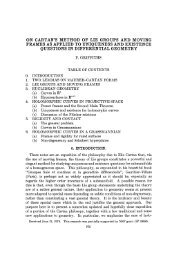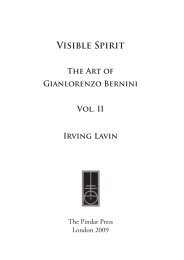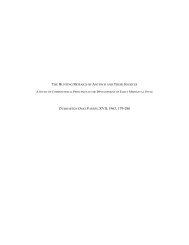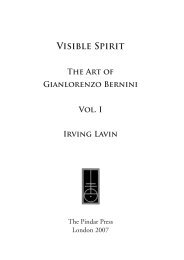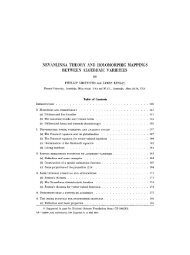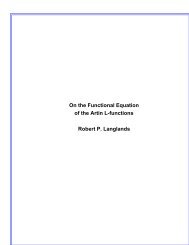View PDF - Project Euclid
View PDF - Project Euclid
View PDF - Project Euclid
You also want an ePaper? Increase the reach of your titles
YUMPU automatically turns print PDFs into web optimized ePapers that Google loves.
we conclude that<br />
CURVATURE AND COMPLEX SINGULARITIES 471<br />
c(flv,)A dpn-= f C(E)Adpn- J*<br />
converges as asserted.<br />
We remark that, upon approaching a singular point z V, as noted above<br />
the Gauss mapping may or may not extend according as to whether or not the<br />
tangent planes T,(V*) have a unique limiting position for all arcs z(t)<br />
--<br />
in V*<br />
which tend to z. Thus when dim V 1 it always extends, and in this case it may<br />
or may not happen that the Gaussian curvature K(z(t)) -o as z(t) z. In<br />
fact the Gaussian curvature remains finite if, and only if, z is an ordinary singularity<br />
of V.<br />
Now we assume that V is smooth except possibly at the origin. Then we will<br />
prove that the function<br />
(3,20) Ik(U, r)<br />
(-1) I c(tv) A n-<br />
r2n- 2k<br />
is an increasing function of r(1). For this we use the notations of section (b)<br />
above. By (.6) the differential form (-l) c(f,) is C, closed, and non-negative<br />
on V* V {0}. Since o d d e log iiz[i is the pullback of the Kfihler form<br />
on IP N- 1,<br />
(3.21) (-1) k ck(l)v) A o n- >- O.<br />
[p,r]<br />
On the other hand, setting<br />
[r]<br />
de I1 11 A<br />
we have from d o and Stokes’ theorem that<br />
(- 1) I ck(t]v) A on (- 1) c(lv) A<br />
v [p,r] V[r]<br />
But on the sphere Ilzll<br />
and therefore<br />
’Ok<br />
(-) c(a) A<br />
ov[p]<br />
Ck(’N) A "Ok t2n- 2k<br />
v[t] v[t]<br />
t2n 2k c(t2v) A (b n- .<br />
It]




